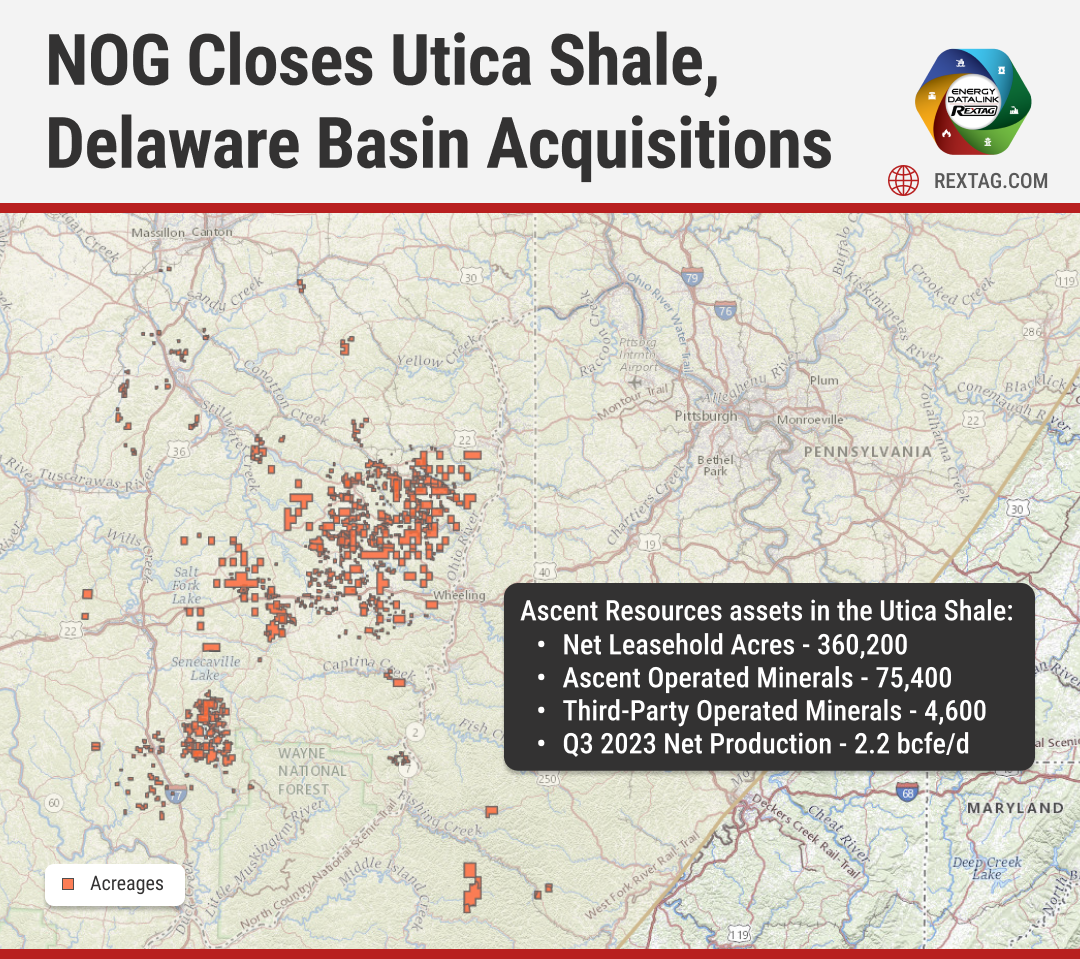Comprehensive Energy Data Intelligence
Information About Energy Companies, Their Assets, Market Deals, Industry Documents and More...
NOG Successfully Acquires Utica Shale and Delaware Basin Operations
02/20/2024
Northern Oil and Gas (NOG) has successfully completed two acquisitions, investing $162.6 million in properties within the Utica Shale and the northern Delaware Basin.
In November 2023, NOG ventured into the Utica Shale by acquiring interests from a private seller, including less than one producing well and slightly over one well in development, spanning several counties in Ohio. These areas, primarily operated by Ascent Resources, focus on extracting oil and gas from the Point Pleasant Formation and the Utica Shale, with the Ohio assets being a significant part of this strategy.
Additionally, NOG expanded its presence in the Delaware Basin through another deal, adding interests in about 3,000 acres in New Mexico's Lea and Eddy counties. This addition complements NOG's existing stakes in the area, covering 90% of the leasehold.
Originally pegged at $174 million, the final investment was adjusted to $162.6 million, including closing costs and adjustments, paid over the end of 2023 and the start of 2024. The payment included a significant deposit made at the agreement signing, with the balance settled in early 2024, subject to final adjustments.
For the second quarter of 2023, NOG reported record quarterly production, highlighting a substantial year-over-year increase in both oil and natural gas production. This growth was part of their updated guidance, which forecasted an annual production range of 96,000 to 100,000 barrels of oil equivalent per day (Boe/d) and set a total budgeted capital expenditure between $764 million to $800 million.
About NOG
NOG stands out as a leading investor in non-operated energy assets across America, focusing on strategic acquisitions in the country's top hydrocarbon-producing regions. The company continues to focus on low-risk, high-return portfolio diversified by geography and commodity, primarily targeting premier regions of the United States such as the Permian, Williston, and Marcellus basins.
If you are looking for more information about energy companies, their assets, and energy deals, please, contact our sales office mapping@hartenergy.com, Tel. 619-349-4970 or SCHEDULE A DEMO to learn how Rextag can help you leverage energy data for your business.
Exxon Mobil and the $60 Billion Deal That Changes Everything in Permian
![$data['article']['post_image_alt']](https://images2.rextag.com/public/blog/272_Blog_Exxon Closes $60B Pioneer Deal in the Permian Basin.png)
Exxon Mobil recently completed its acquisition of Pioneer Natural Resources, a deal worth about $60 billion. This transaction, which is the biggest in shale oil history, significantly changes the competitive landscape in the Permian Basin, a major oil field. This marks Exxon Mobil's largest deal since its $84.4 billion merger with Mobil Corp. in 1999. With this acquisition, Exxon Mobil's production in the Permian Basin will double to 1.3 million barrels of oil equivalent per day.
TOP 2022 vs 2023 Permian Producers Overview by Rextag
![$data['article']['post_image_alt']](https://images2.rextag.com/public/blog/R242_Blog_Permian Producers Overview by Rextag.png)
The Permian Basin, America's prime oil region, faced significant challenges during the COVID-19 pandemic. The industry saw a drastic reduction in rigs and fracking crews and had to close some operations as oil prices plummeted, leading to widespread restructuring. Now, the Permian is making a strong comeback. Over the last three years, exploration and production companies (E&Ps) have increased their drilling activities. They're focusing on spending wisely and maximizing returns to their investors. The Permian's role is crucial. It was projected to contribute over 5.98 million barrels of oil per day in December, making up about 62% of the total oil production in the Lower 48 states, as per the EIA.
![$data['article']['post_image_alt']](https://images2.rextag.com/public/blog/328_Blog_Why Are Oil Giants Backing Away from Green Energy Exxon Mobil, BP, Shell and more .jpg)
As world leaders gather at the COP29 climate summit, a surprising trend is emerging: some of the biggest oil companies are scaling back their renewable energy efforts. Why? The answer is simple—profits. Fossil fuels deliver higher returns than renewables, reshaping priorities across the energy industry.
![$data['article']['post_image_alt']](https://images2.rextag.com/public/blog/327_Blog_Oil Market Outlook A Year of Growth but Slower Than Before.jpg)
The global oil market is full of potential but also fraught with challenges. Demand and production are climbing to impressive levels, yet prices remain surprisingly low. What’s driving these mixed signals, and what role does the U.S. play?
![$data['article']['post_image_alt']](https://images2.rextag.com/public/blog/326_Blog_USA Estimated Annual Rail CO2 Emissions 2035.jpg)
Shell overturned a landmark court order demanding it cut emissions by nearly half. Is this a victory for Big Oil or just a delay in the climate accountability movement?